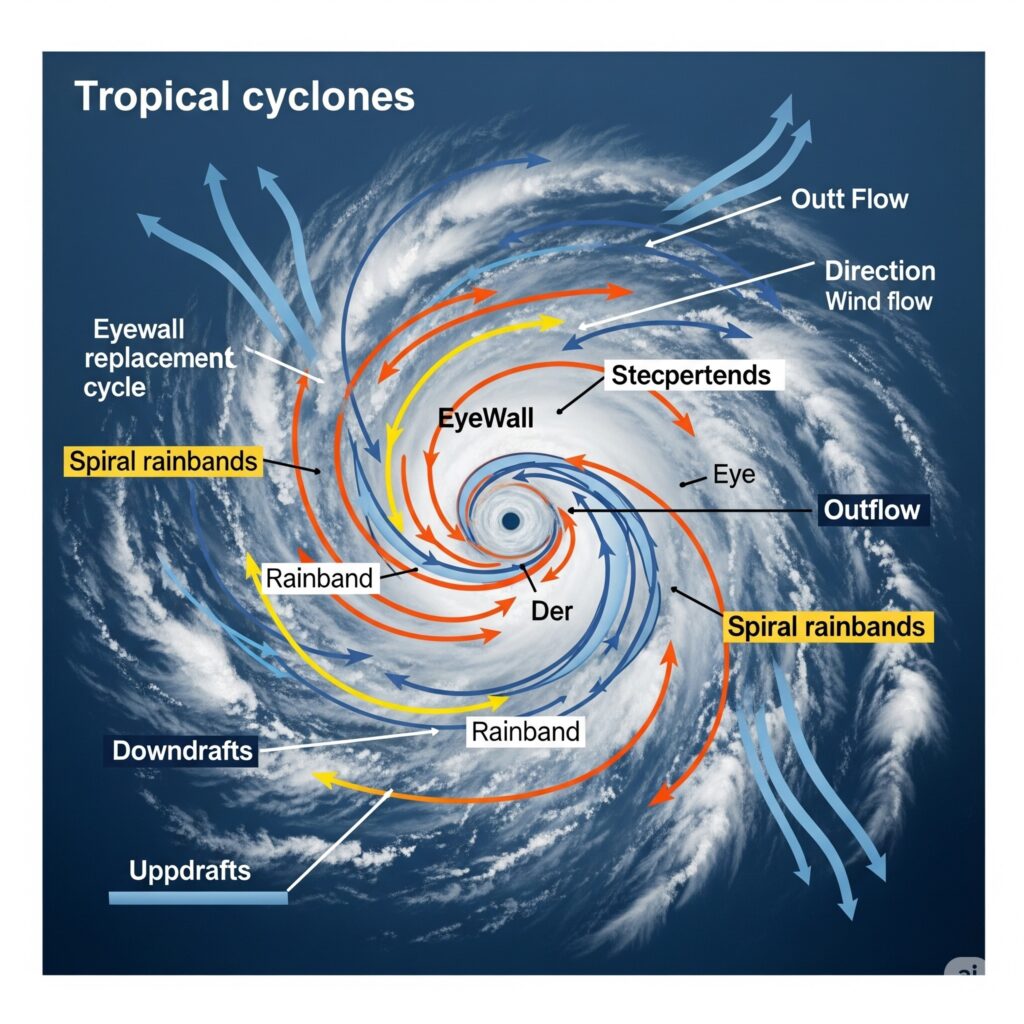A Tropical Cyclone is a weather condition that forms over tropical and subtropical water. These weather systems are known for their strong winds, heavy rainfall, and high waves, and they can have a significant impact on coastal communities and surrounding areas.

Table of Contents
Formation of Tropical Cyclone
Tropical cyclones form over warm tropical and subtropical water, where the conditions are favorable for their development. For a tropical cyclone to form, several conditions must be met, like warm water temperature, moist air, and weak vertical wind. The formation of a tropical cyclone begins with the development of a low-pressure area over warm waters. As the low-pressure area develops, moist air rises and forms thunderstorms. The rising air and thunderstorms create an area of low pressure at the surface, which leads to the formation of a tropical depression.
The formation of a tropical cyclone begins with the development of a low-pressure area over warm waters. As the low-pressure area develops, moist air rises and forms thunderstorms. The rising air and thunderstorms create an area of low pressure at the surface, which leads to the formation of a tropical depression.
As the tropical depression continues to develop, the winds begin to circulate the low-pressure area, creating a circular wind pattern. As the winds increase in speed, the depression becomes a tropical storm, and if the winds reach hurricane force, the tropical storm becomes a tropical cyclone.
The Ideal Conditions for the Formation of Tropical Cyclone
- Warm ocean waters: The ocean waters need to be at least 26.5°C (80°F) to provide the energy required for the storm to develop and strengthen.
- Moisture: The atmosphere needs to be moist to provide the necessary humidity for the storm to form and maintain its strength.
- Coriolis force: Tropical cyclones require the Coriolis force, which is caused by the Earth’s rotation, to develop and maintain their rotation.
- Low vertical wind shear: Wind shear can disrupt the vertical structure of the storm, so low vertical wind shear is necessary for a tropical cyclone to form and strengthen.
- Instability in the atmosphere: The atmosphere needs to be unstable, which means that the air near the surface needs to be warmer than the air at higher altitudes, allowing the air to rise and form clouds.
- A pre-existing disturbance: Often, a pre-existing disturbance such as a tropical wave or low-pressure system is needed to start the cyclone’s development.
- Location: Tropical cyclones typically form in the warm waters of the tropics, between 5° and 30° latitude, in areas where the ocean waters are warm and the atmospheric conditions are favorable.
Structure of Tropical Cyclones
Tropical cyclones have a well-defined structure, with distinct features that help meteorologists identify and track these weather systems.
"The center of the tropical cyclone is called the "eye," and it is characterized by weak winds and clear skies."
Around the eye, there is an eyewall, which is the area of strongest winds and heaviest rainfall. The eye wall is where the most damaging winds and rainfall occur, and it is important to be prepared for the impacts in this area.
Impact of Tropical Cyclones on Weather
Tropical cyclones have a significant impact on the weather patterns in many coastal communities and surrounding areas. As they move, they bring with them strong winds, heavy rainfall, and high waves, which can cause damage and disrupt transportation.
In addition to the strong winds and heavy rainfall, tropical cyclones can also bring storm surges, which are large waves that can cause flooding in coastal areas. The storm surges combined with the heavy rainfall can lead to significant flooding, making it important to track tropical cyclones and be prepared for any potential impacts.
Preparation and Response
Coastal communities and surrounding areas need to be prepared for the potential impacts of tropical cyclones. This includes having a disaster plan in place, securing loose items outside, and stockpiling supplies, such as food and water.
When a tropical cyclone is approaching, it is important to stay informed and follow the advice of local authorities. If you are in an area that is under a tropical cyclone warning, it is important to evacuate if advised to do so and to seek shelter in a safe place.
Comparison with Temperate Cyclone
| Aspect | Tropical Cyclones | Temperate Cyclones |
|---|---|---|
| Location | Typically form over warm ocean waters near the equator | Form in mid-latitudes, often over land or ocean |
| Source of Energy | Primarily fueled by latent heat released from warm ocean water | Fed by temperature contrasts between air masses |
| Structure | Characterized by a warm core and spiral bands of thunderstorms | Typically have a cold core and frontal boundaries |
| Wind Speed | Can reach extremely high wind speeds, often exceeding 200 mph | Wind speeds generally range from 30 to 70 mph |
| Size | Generally smaller in size compared to temperate cyclones | Tend to be larger and cover a broader geographic area |
| Duration | Typically last for a week or more | Can last for several days to a week |
| Seasonality | Peak activity during specific seasons (e.g., hurricane season) | Can occur throughout the year, with varying intensity |
| Steering Factors | Influenced by high-pressure systems and the Coriolis effect | Affected by the jet stream and other atmospheric patterns |
| Impact | Can cause catastrophic damage to coastal areas | Can produce a range of weather, including rain and snow |
| Name Variations | Known as hurricanes, typhoons, or cyclones depending on the region | Also referred to as extratropical cyclones or lows |
Read: Geography